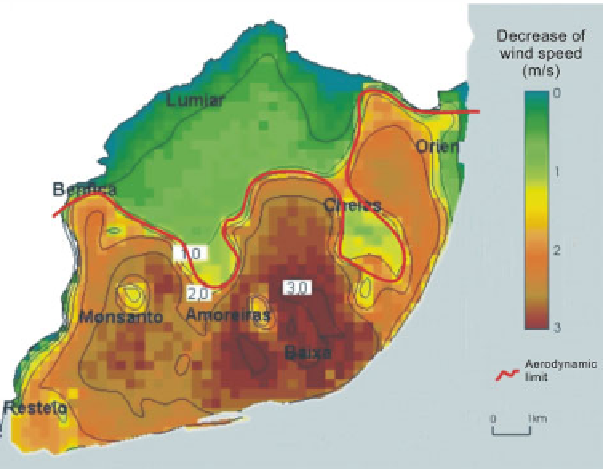Geoscience Reference
In-Depth Information
Figure 5.10.
Decrease of wind speed (m/s) at 10 m high during summer
days of strong N wind (v>5 m/s) for the 1980s, simulated
by WAsP software [LOP 03; LOP SUB] (see color section)
As the N and NW winds are the prevailing wind directions, and there has been a
very rapid growth of the northern city districts, wind speed will most probably tend
to decrease in “Baixa” (near Restauradores, Figure 5.4b). In order to estimate the
summer moderate and strong
N wind modifications brought about by city growth,
another wind dataset was obtained that contained only directions from 45º to 315º
and speeds above 5 m/s (the WAsP software performed the necessary data
modifications providing all the new parameters, i.e. frequencies,
A
, and
k
values)
[LOP SUB]. By running this new dataset, Lopes represented spatially the average
reduction of summer wind speed in the 1980s at several heights above the surface
[LOP 03]. Figure 5.10 shows the reduction at 10 m high. The greater decrease
occurs in “Baixa”. The districts of eastern Lisbon, which were then less urbanized,
suffer a smaller decrease. Wind speed is also reduced in the Monsanto hill because it
is covered with forest and has therefore high z
0
values (Figure 5.9).
There are still some ventilation corridors in Lisbon that provide a renewal of
clean and cooler air from the N [ALC 09]. Should these paths be obstructed a
probable reduction of the air flux would occur and more frequent calm conditions
would be observed. A subsequent impoverishment of air quality, as well as comfort
and health for city dwellers, are to be expected.
5.7.3.2.
Summer wind breezes
As mentioned before, the summer wind regime in Lisbon is dominated by the N
and NW winds (Figure 5.6). Observational studies on summer winds in Lisbon and


























